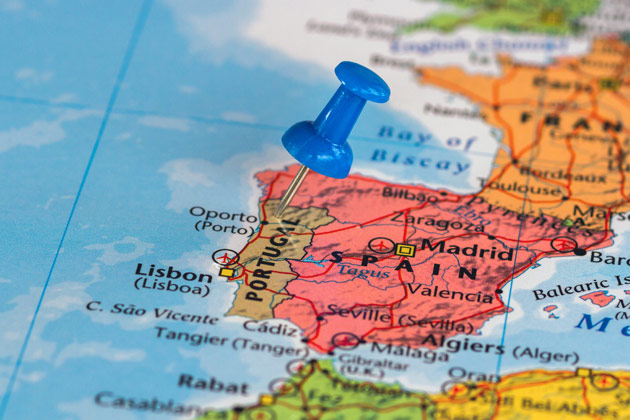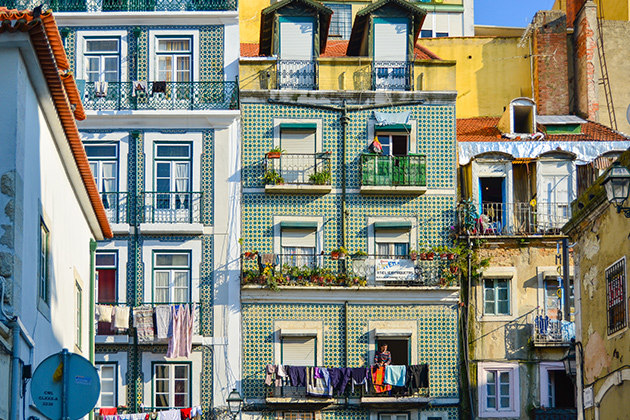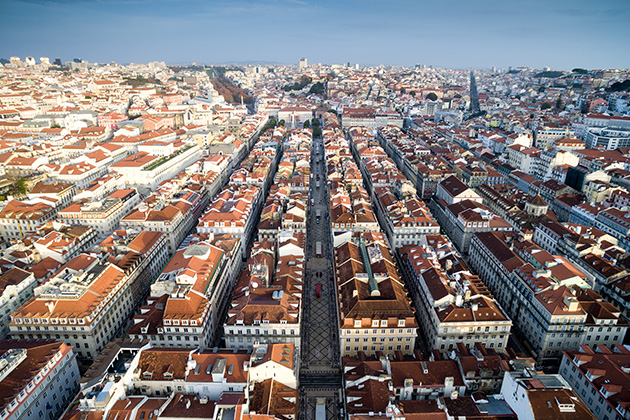
With charismatic shops and magnificent monuments, downtown Lisbon is the historical heart of the Portuguese capital. Come with us on a guided tour.
1755 and downtown Lisbon today
Most of the capital of Portugal was razed by the massive earthquake of 1755. After “burying the dead and caring for the living”, the Marquis of Pombal, prime minister to King D. José I, delved into the task of building the whole city anew. This is how downtown Lisbon as we know it today came to be, and why it is also known locally as the Baixa Pombalina.
The area covers around 255 hectares, from the Terreiro do Paço square, on the bank of the Tagus, to the Marquês de Pombal Square, at the top of the large Avenida da Liberdade, and is spread over the territory currently occupied by the parish of Santa Maria Maior.
Known for the perpendicular design of its streets, centred around Rua Augusta, downtown Lisbon is dominated by the Pombal style which replaced the medieval and organic urban layout with wide roads and pavements, constructed under the supervision of Manuel da Maia, Eugénio dos Santos and Carlos Mardel.
The buildings are architecturally similar, with ground floors used for shops and the upper levels reserved for housing. The size of the buildings is another of the characteristics of downtown Lisbon and points to the birth of a new social order that appreciates and values the financial and commercial classes.
Going down to the heart of downtown Lisbon
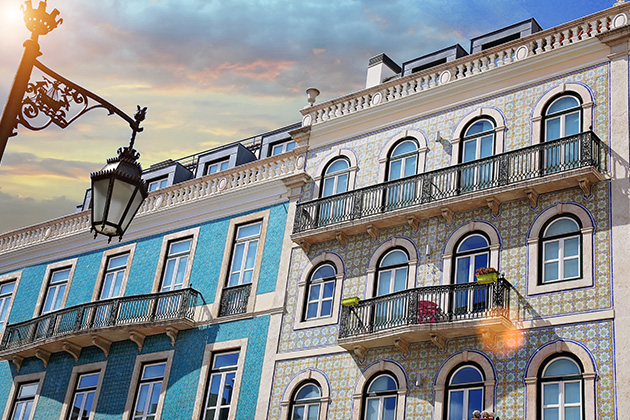
As the city’s most central and commercial neighbourhood, downtown Lisbon also boasts the largest amount of entertainment options, bustling with cultural, gastronomical and leisure alternatives. Here you will find some of the most emblematic streets in Lisbon, whose façades are covered with magnificent tiles that still seduce us today. Now, let’s go down the avenue towards the river.
Avenida da Liberdade
This avenue connects the Marquês de Pombal Square to the Restauradores Square. You’ll find yourself walking down about one kilometre, flanked on both sides by XIX and early XX Century buildings and in the company of statues of important literary figures such as Almeida Garrett and Alexandre Herculano.
Many of the original buildings have been replaced with offices and the hotels that make this one of the best in terms of the hospitality industry. The pavements are made of traditional black and white cobble designs and lead you past several cafés and terraces, monuments and gardens.
This is also where you will find the most high-end and expensive shops run by famous international clothes and jewellers, and of the fashion industry in general. The classical concert halls that attract both tourists and locals are also in the vicinity, such as the Tivoli or the São Jorge Cinema. Lisbon’s central avenue is ranked as the 35th most expensive in the world and real estate prices are quite high.
Praça dos Restauradores
At the end of the avenue you’ll find the Praça dos Restauradores, a wide-open space with an obelisk at the centre that marks the liberation of Portugal from Spanish domination, in 1640.
The central square is paved in traditional Portuguese cobble stones, in the artistic style of famous Portuguese architect and painter João Abel Manta. Real estate prices in this downtown Lisbon square are very similar to the those of the Avenida da Liberdade and architecturally one of the landmarks is the Palácio Foz, with its Baroque façade (this is where you will find the tourist information centre) and the Eden Theatre and the Condes Cinema, which are examples of Art Deco architecture.
Visit the terrace on the rooftop of the Eden and enjoy the wonderful view it commands. On the opposite side of the Condes Cinema you can get climb aboard the Glória Elevator and let it take you to the Bairro Alto, as it has been doing since 1885.
Rossio
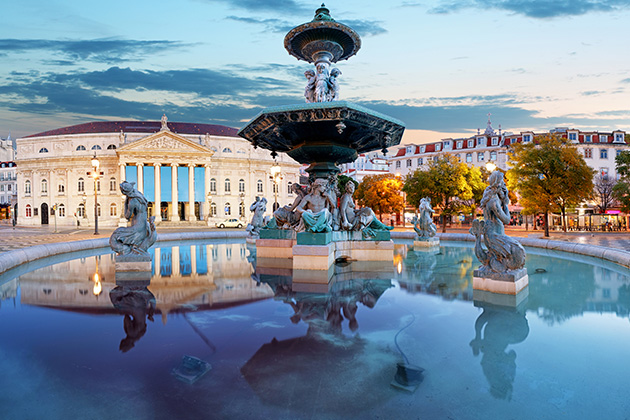
The Praça dos Restauradores gives us access to the Rossio, a square that dates to the XIII Century and represents one of the city’s busiest points. Although it continues to be known as the Rossio, it is formally called Praça D. Pedro IV.
In Roman times this used to be a racetrack and in the 1400s an affluent of the Tagus ran through here which led it to be known as Valverde. Many important episodes of Portuguese history took place in this spot, which has always been used for fairs and markets and which, in the XV Century became the home of the Todos os Santos Hospital.
Just off a side street you will find the São Domingos Church, one of the most remarkable in the country, which witnessed the merciless persecution of the Jews in trials held by the Inquisition.
Following the earthquake of 1755, the square was rebuilt according to Carlos Mardel’s plan. The Treasury was replaced by the D. Maria II National Theatre, in 1849, surrounded by trees, monumental fountains and basalt and limestone cobbled pavements showing traditional Portuguese mosaics.
The famous Café Nicola, where poet Barbosa du Bocage improvised sonnets and satire still exists, but many of the more traditional Pombal style buildings have been renovated and reflect the most expensive parts of the city in terms of real estate prices. The commercial establishments are mostly memorabilia shops, jewelers and cafés.
Make sure to visit the Mónaco Tobacconist that used to connect the Rossio to the 1º de Dezembro street and where you can still appreciate the long Brazil wood bar and closets, the Bordalo Pinheiro swallows and António Ramalho frescoes. Further on you can wrap your head around the tradition and comfort of the Chapelaria Azevedo which has been in the business of making hats since 1886.
Praça da Figueira
Located next to the Rossio, the classical buildings and the King D. João I statue in Praça da Figueira are bound to leave an impression. In the heart of downtown Lisbon, the Praça da Figueira used to share the Todos os Santos Hospital with the Rossio but following the earthquake this is where the city’s main market was installed, supplying Lisbon with meat and vegetables, only to be demolished later on.
As the years went by the buildings that used to surround the square gave way to hotels, shops and cafés, which now dominate this typical Lisbon square.
Since 1829 the Confeitaria Nacional has been standing guard on one of its corners and to this day it continues to seduce those who enter, having made a name for itself through the introduction of the famous Christmas season bolo-rei. Nearby, in the São Domingos square you must also visit the Ginginha Espinheira tavern, open since 1840, for a shot of this traditional Portuguese liqueur.
Rua Augusta
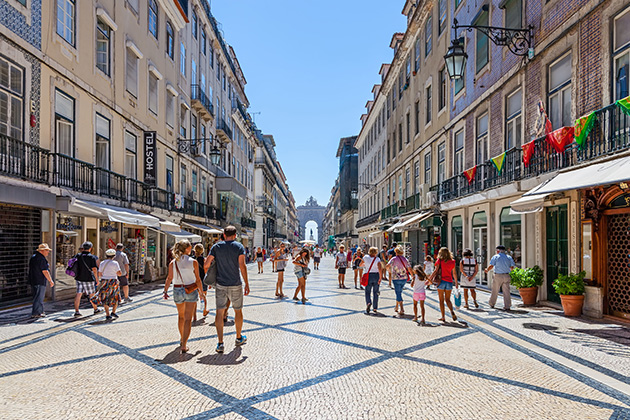
Connecting the Rossio to the Terreiro do Paço (also known as Praça do Comércio), Rua Augusta is one of downtown Lisbon’s most famous streets, and has been for a while. At the end closest to the river it is capped by a triumphal arch that overlooks the Terreiro do Paço and the river waters. The statue at the top is a tribute to the august figure of King D. José I.
There is a high concentration of commerce here, with large clothes shops of some of the leading international brands, but also several pastry shops, restaurants and cafés, that spill out into terraces, inviting you to sit back, relax and watch people go by on this street that has been closed to traffic since the 80s.
At number 272 you’ll want to pay a visit to Casa Macário, where drinks, candy, coffee, tea and chocolates have been sold since 1913, with many customers coming for the Port Wine. The street itself is full of improv artists, artisans and street venders fighting for your attention.
The parallel Ouro (don’t miss out on a visit to the Araújos goldsmith shop, open since 1878) and Prata streets are named after the trades traditionally practiced therein, namely, and respectively, gold and silver. The rule applies to most of the streets in this part of downtown Lisbon, such as Fanqueiros (cloth), Sapateiros (cobblers), Douradores (gilders) and Correeiros (saddlers).
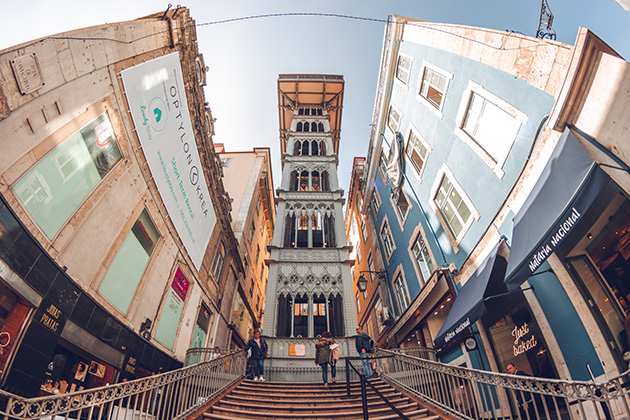
A definite must is the Santa Justa elevator, that connects the Rua do Ouro to the Largo do Carmo, in the Chiado district, uphill. This is one of downtown Lisbon’s most interesting monuments, cast in iron and in a neogothic style, it began to be built in 1900 and was open for business two years later. It doubles as a very useful mode of transport and a fantastic belvedere, commanding a unique view over downtown Lisbon from the upper level.
In the side streets you’ll find the historical haberdashers, full of material, buttons, ribbons and any number of sewing instruments that are bound to make you lose your head and want to open all the little drawers that cover the walls of these establishments.
Terreiro do Paço
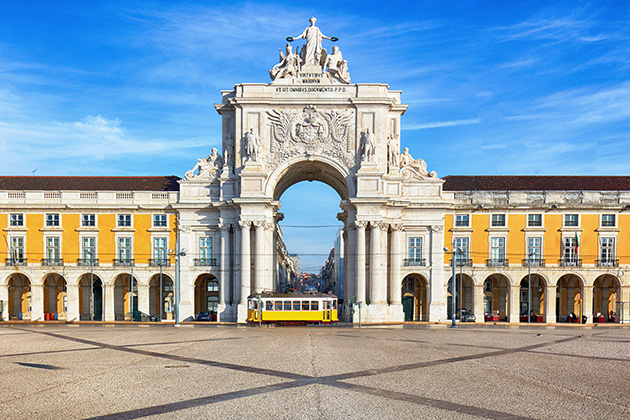
The Terreiro do Paço, that sits right next to the Tagus River, is also known as Praça do Comércio and is one of Europe’s largest squares, at around 36 thousand square meters, harking back to days when, for over two hundred years, the quarters of the Royal Family were located here.
Nowadays these have been adapted to house several governmental departments, cultural activities, hotels, restaurants and cafés, such as the famous Martinho da Arcada, the oldest café in Lisbon, which was attended frequently by renowned poet Fernando Pessoa.
A statue of a mounted D. José stands at the centre of the square, which often hosts cultural events and outdoor shows. This point of downtown Lisbon is deeply intertwined with crucial moments in Portuguese history, such as the murder of King D. Carlos and Prince D. Luís Filipe in 1908, or the landing of Queen Elizabeth II when she visited Portugal in 1957.
Some of the key episodes of the overthrow of the dictatorship in 1974 also took place here and as recently as 2010 Pope Benedict XVI celebrated an outdoor mass for 280 thousand people. The cultural offer is very rich in this point of the city, which is also home to the Lisboa Story Centre, which tells some of the history of the Portuguese capital, including a re-enactment of the 1755 earthquake.
The Praça do Comércio, or Terreiro do Paço, is perhaps the most magnificent square in Portugal, bravely and smugly overlooking the Tagus, perhaps secure in the knowledge that it will outlive it.
